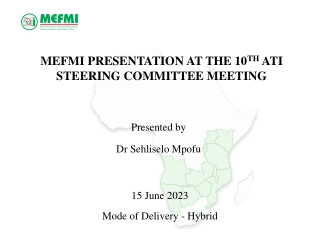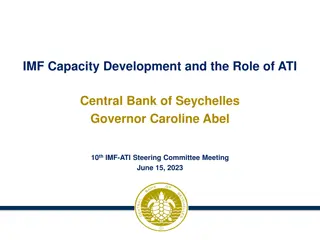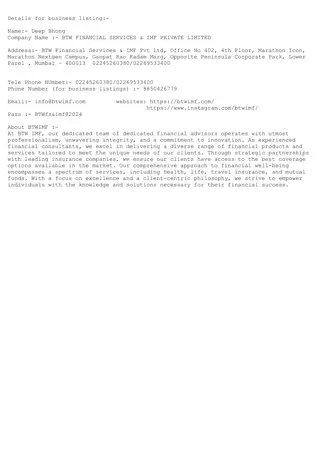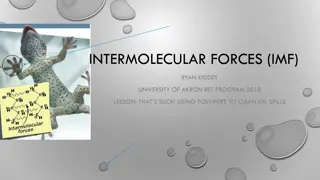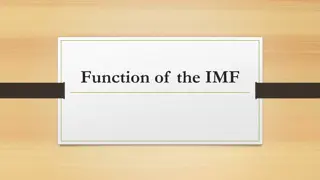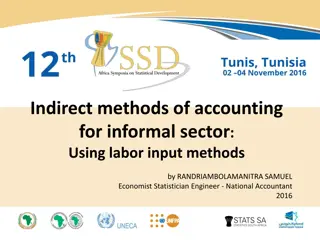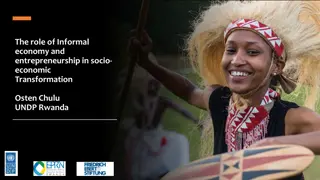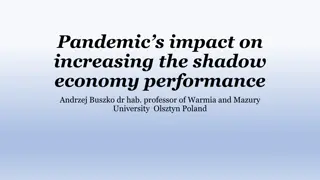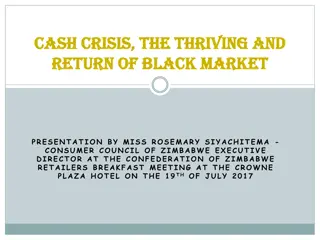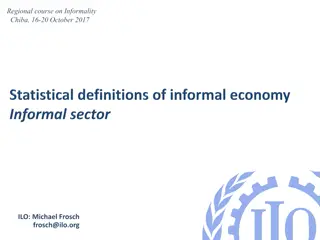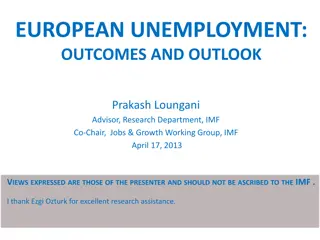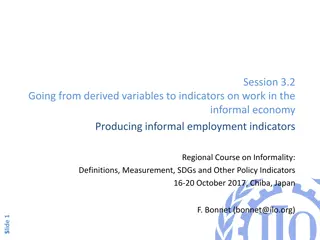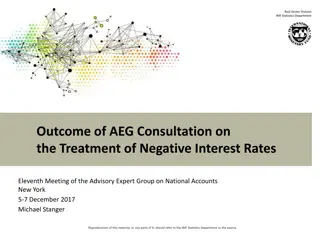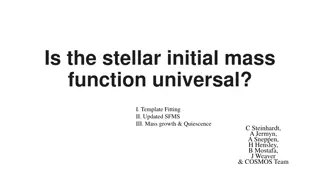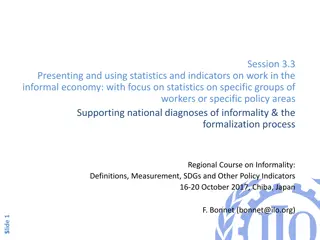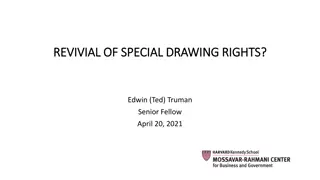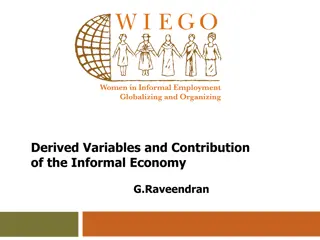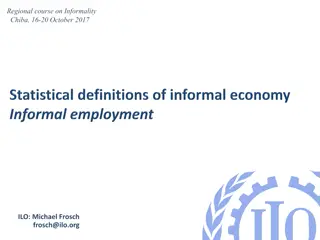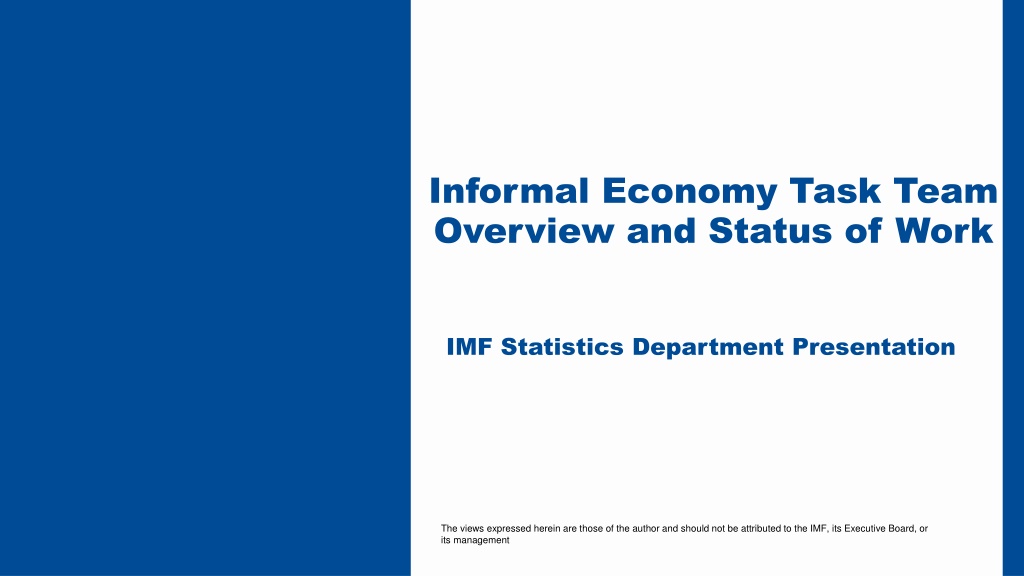
Insights into the Informal Economy: Policy Implications and Analytical Concepts
Explore the Informal Economy Task Team's work and the significance of measuring the informal economy from social and economic perspectives. Understand the fragmentation of the informal economy and the push for a statistical concept to capture its productive activities. Discover why policymakers are interested in this sector and the challenges it poses in terms of economic growth, productivity, and social protections.
Download Presentation

Please find below an Image/Link to download the presentation.
The content on the website is provided AS IS for your information and personal use only. It may not be sold, licensed, or shared on other websites without obtaining consent from the author. Download presentation by click this link. If you encounter any issues during the download, it is possible that the publisher has removed the file from their server.
E N D
Presentation Transcript
Informal Economy Task Team Overview and Status of Work IMF Statistics Department Presentation The views expressed herein are those of the author and should not be attributed to the IMF, its Executive Board, or its management IMF IMF | Statistics 1
Outline Outline Policy Interest in the Informal Economy Concepts: Informal Economy versus Nonobserved Economy IMF Policy Paper Informal Economy Task Team (IETT): Mandate IETT Guidance Notes METAC s Work on the Informal Economy IMF IMF | Statistics 2
Policy Implications of Measuring the Informal Economy Policy Implications of Measuring the Informal Economy Why are policymakers interested in the informal economy Social Perspective Economic Perspective Informal jobs provide employment and income to persons who might otherwise be unemployed Economic growth and productivity Low productivity Lower and uncertain income Low tax revenue limit the government s ability to spend on social programs and invest in public goods Exclusion from social protections Inequality and poverty. Digitalization and the growing gig economy (role of independent contractors) These issues came to the fore under the COVID 19 pandemic IMF IMF | Statistics 3
What is the Informal Economy What is the Informal Economy Fragmentation Fragmentation Conceptual Conceptual Shadow economy underground economy unrecorded economy grey economy black economy and about 30 different terms* Common themes (emphasis may change) the part of the economy that is missing or not easily covered in official statistics, production taking place outside the regulated economy, the production of households. much of the policy discussions and measurements are affected by these varied, broad definitions that are not always consistent. * Handbook on Measuring the Non-observed Economy (2002) IMF IMF | Statistics 4
Informal Economy Informal Economy Analytical Concept Analytical Concept Analytical concept: All economic activities by workers and economic units that are in law and in practice not covered or insufficiently covered by formal arrangements (ILO, 2002). But: Not developed as a statistical concept Goal: Develop a statistical concept that takes account of the frameworks of informal sector and informal employment, thereby establishing the necessary link between the statistical measurement of informality and the policy purpose of measuring it. A statistical concept of the informal economy would need to capture productive activities work relationships that are not formally recognized. IMF IMF | Statistics 5
Non Non- -observed Economy observed Economy Range of activities that are most likely to be non-observed as well as activities that may be missed because of deficiencies in the regular data collection programs (The Non-observed Economy A Handbook, 2002) Not synonymous with the informal economy Considerable overlap between the two because many of the factors that give rise to informality may also result in the units being non-observed IMF IMF | Statistics 6
Background: IMF Policy Paper on Measuring the Background: IMF Policy Paper on Measuring the Informal Economy (2020) Informal Economy (2020) An internationally agreed statistical framework for measuring the informal economy has been lacking. Consequently, the informal economy has been defined and estimated based on diverse criteria depending on varying research and policy motivations. Based on the proposed framework, the informal economy comprises production of informal sector units, production of goods for own final use, production of domestic workers, and production generated by informal employment in formal enterprises. This proposed framework will facilitate preparation of estimates of the informal economy as a component of GDP Paper proposes a framework for measuring the informal economy that is consistent with internationally agreed concepts and methodology for measuring GDP. IMF IMF | Statistics 7
Mandate of IETT Mandate of IETT Mandate spans mostly Phase I of the update process (now to March 2022). Within that timeframe, the IETT is expected to: undertake thorough research on informal economy issues discuss and reach conclusions, with proposals to be presented to the AEG/ISWGNA, BOPCOM and the ILO Working Group for the Revision of the Standards for Statistics on Informality propose a testing and experimentation strategy for the guidance notes IMF IMF | Statistics 8
Mandate of IETT Mandate of IETT Prepare guidance notes that: Present a coherent set of statistical standards necessary for measurement of work and economic activity, including cross-border transactions, in the informal economy. Identify and delineate the statistical issues on the informal economy that should be addressed as part of the update of the Manuals Guidance notes should take account of country practices and contribute to global coverage and harmonization of statistics on the informal economy across countries. To avoid duplication, IETT will: Take account of current or completed work on topics related to research issues under its purview. Coordinate with other Task Teams or Working Groups. IMF IMF | Statistics 9
What is the Informal Economy What is the Informal Economy 2008 SNA 2008 SNA 2008 SNA outlines two approaches with different goals that overlap but are NOT the same Exhaustiveness: Ensure that all activities including those that may be described as hidden or underground are encompassed in measures of total activity Goal is an accurate measure of economic activity A view of the economy that is as complete as possible and that can be compared over time and across countries, as possible Related to the concept of the Non-observed economy Define what is meant by the subset of economic units that can be considered informal Recognizes the analytical importance, especially in developing countries, of measuring that part of the economy that reflects the contribution of people without formal jobs to economic activity IMF IMF | Statistics 10
Guidance Notes Guidance Notes October 2021 A: Overarching Guidance Note: Statistical Definition and Scope B: Informal Economy and Cross Border Flows C: Informal Economy and Digitalization February 2022 D: Informal Economy Presentational Framework IMF IMF | Statistics 11
Guidance Note A: Statistical Definition and Scope Guidance Note A: Statistical Definition and Scope Overarching guidance note Statistical framework and classification of informal economy (including identifying aspects of the informal economy in existing classification systems) A common/ integrated conceptual and operational definition of the informal economy, taking account of various concepts of informality informal sector; informal employment relationship to informal economy Build on the ongoing work of the ILO Working Group IMF IMF | Statistics 12
Guidance Note B: Informal Economy and Cross Guidance Note B: Informal Economy and Cross Border Flows Border Flows Production in the informal economy that may be directly related to cross-border transactions mainly in the current account Household production of tourism services for non-residents, including vacation rental services and operating small eating establishments. Remittances transmitted through informal channels by workers without access to formal financial institutions. the informal hawala system predominantly used in the Middle East and South Asia, represents one form of informal money transfer. These workers may also be engaged in informal employment, including short-term and seasonal work, because they may not have the appropriate employment permits. Income from informal economy production may also be transmitted through formal money transfer channels. IMF IMF | Statistics 13
Guidance Note C: Informal Economy and Guidance Note C: Informal Economy and Digitalization Digitalization Relationship between digitalization and the informal economy: Collaboration with the Digitalization Task Team Production activities facilitated by digitalization Ride sharing services (Uber) Accommodation services (Airbnb) Source of Data Digital platforms can be a useful source of data on informal activity as they provide a link between formal enterprises and the informal economy Conventional household surveys and enterprise surveys may need to be transformed to collect comprehensive information on the production of households. IMF IMF | Statistics 14
Guidance Note D: Informal Economy Presentational Guidance Note D: Informal Economy Presentational Framework Framework Presentation in the system of national accounts and the external sector statistics to ensure users have a clear understanding of the informal economy and its evolution. How aspects of the informal economy may be identified in existing classifications and accounts or the development of special classifications and accounts. Recognize the flexibility of the statistical standards to provide for alternative presentations of the underlying accounting frameworks while remaining internally consistent and integrated. IMF IMF | Statistics 15
Terms of Reference and other information on the work of the IETT available at: https://www.imf.org/en/Data/Statistics/BPM/IETT IMF IMF | Statistics 16
The non The non- -observed economy in METAC member observed economy in METAC member countries countries The informal economy represents a significant proportion of the total economy in many of the 14 countries covered by METAC According to national statistics offices, the proportion is as high as 20% and could go up to over 45% in the more fragile states The industries most heavily affected by informality are: construction, retail, and transport IMF IMF | Statistics 17
Technical assistance by METAC Technical assistance by METAC Since 2018, IMF s Middle East Regional Technical Assistance Center (METAC) has provided 48 direct (single-country) technical assistance missions on national accounts to twelve of its fourteen members Twenty-five percent of these activities directly or indirectly addressed the measurement of the non-observed economy Indirect technical assistance activities were mainly related to the compilation of supply and use tables Supply and use tables provide a mechanism to help achieve exhaustive GDP estimates, as they facilitate the detection of undercoverage in the source data the process of balancing the supply and use at a detailed product-by-product level, provides the opportunity to analyze the causes of discrepancies, make necessary adjustments and fill data gaps when necessary Supply and use tables are also ideally suited to implement indirect methods for measuring the non-observed economy based on demand-side indicators e.g. the output of hairdresser services, unregulated taxi services, and small-scale agriculture can be estimated based on the consumption of these goods and services by households. IMF IMF | Statistics 18
Increasing demand for technical assistance on non Increasing demand for technical assistance on non- - observed economy measurement observed economy measurement Two activities directly addressing measurement of the non-observed economy were included in METAC s workplan in FY2021: Egypt In response to a request from the Ministry of Planning and Economic Development, a remote technical assistance mission was conducted in April to assist the authorities to improve the measurement of the non-observed economy in the annual national accounts and the supply and use tables. The mission provided training on concepts, definitions, and estimation methods; reviewed source data for the non-observed economy; and identified improvements required to improve GDP exhaustiveness. Regional workshop Intended for government officials who are integrally involved in the compilation of national accounts statistics, a workshop is being jointly organized by METAC and the Center for Economics and Finance in Kuwait in November The workshop will broaden participants understanding of the framework, concepts, definitions and estimation methods regarding the non-observed economy. IMF IMF | Statistics 19


